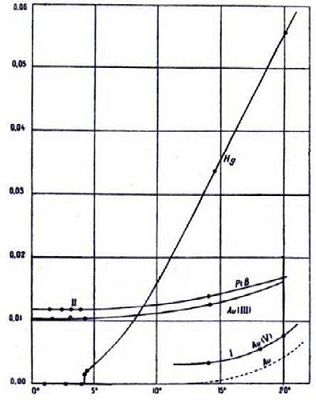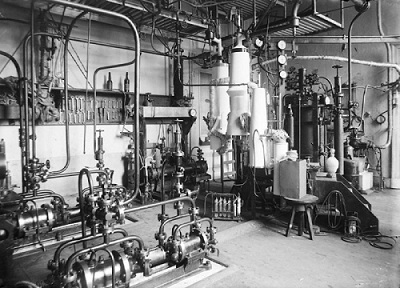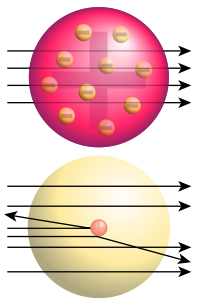1911: The year superconductivity was discovered: Difference between revisions
No edit summary |
No edit summary |
||
| Line 50: | Line 50: | ||
Consider the discoveries and inventions listed at the beginning of this article. Now consider the magnetic resonance imaging machine at the local hospital This MRI machine uses a magnetic field to temporarily align the water molecules in the body which vibrate when radio waves are sent through the body. The produced signals can be used to create three dimensional cross sectional images of the tissue inside the body that can be rotated and viewed from many angles. <ref>http://www.mayoclinic.com/health/mri/MY00227</ref> Now consider the future as the phenomenon of superconductivity begins to be more and more understood by scientists. | Consider the discoveries and inventions listed at the beginning of this article. Now consider the magnetic resonance imaging machine at the local hospital This MRI machine uses a magnetic field to temporarily align the water molecules in the body which vibrate when radio waves are sent through the body. The produced signals can be used to create three dimensional cross sectional images of the tissue inside the body that can be rotated and viewed from many angles. <ref>http://www.mayoclinic.com/health/mri/MY00227</ref> Now consider the future as the phenomenon of superconductivity begins to be more and more understood by scientists. | ||
Revision as of 23:28, 20 April 2011
One hundred years ago a group of scientists stumbled upon a phenomenon that had never before been observed. With applications way ahead of its time this discovery phenomenon has become a major research attraction in the world of physics. Even one hundred years after its discovery very little is known about it.
Introduction
The following is a recount of some of the events leading up to the end of the first decade of the twentieth century.

In 1901, an Italian inventor named “Guglielmo Marconi transmitted a Morse code signal across the Atlantic Ocean” to Newfoundland, Canada, setting loose a pursuit of wireless communications systems. In 1903, the first motor airplane was launched in the United States by the Wright brothers. [1] In 1907, Belgian chemist Leo Baekeland discovered the first entirely synthetic material, which could retain its shape even in heat and household acids. [2] “Bakelite,” as it was called, was a combination of phenols and formaldehyde.

In 1908, Henry Ford, an American entrepreneur, created a system for mass production and planned to introduce the world to his Model T automobile. This was the first automobile for the common man. [3] By 1911, the airplane flight record was held at 91 miles per hour for a distance of 206 miles by a Frenchman named Pierre. An abstract art movement called Cubism had taken hold across all of Europe due to the pioneering of the Spanish painter Pablo Picasso. Industrialization was quickly filling in the gaps in the Western world, and the average life expectancy was about fifty-four years. Japan was emerging from two hundred years of complete isolation, and Great Britain was the world’s economic power. [4] Europe was a restless place as it grew ever closer to the beginning of World War One in 1914.
From Thompson to Bohr
The year is nineteen hundred eleven. It is the beginning of what will be one of the most influential centuries in physics. In the course of the next century there will be an explosion of scientific discovery concerning the most basic components that make up this world.
Among the developments of physics in the 20th century are both the quantum mechanics and the standard model of particle physics which will forever change the way in which the world is perceived by attempting to explain and understand the smallest particles that form the universe. This amazing era of discovery was ushered in by a new model of the atom, which differed from the previous models in that it consisted of a dense core which was orbited by small particles moving very fast.
In the decade preceding 1911, the best supported model of the atom was known as the “Plum Pudding” model as coined by the British Physicist J.J. Thompson, who discovered the electron in 1897 and proposed this model in 1904. Based on his knowledge, Thompson described the atom as a collection of negative charges surrounded by a positively charged soup or cloud. This model only really sought to explain the neutrality of the atom and it described the atom as having an even distribution of charge. By 1909, Thompson’s model had been disproven by what is now commonly known as the “Gold Foil Experiment,” which was performed at the University of Manchester by Hans Geiger and an undergraduate student named Ernest Marsden. The research was directed by Ernest Rutherford who had previously been a student of Thompson’s. This experiment showed that the atom could not have an even distribution of charge over a small area, but a very small, massive, highly concentrated area of positive charge. Thus, in 1911, Rutherford proposed a model of the atom in which the positively charged nucleus had a radius 10,000 times smaller than the radius of the entire atom, and it was surrounded by a cloud of negatively charged electrons. Four years later, Niels Bohr woulf specify Rutherford’s model further by describing the orbits of the electrons as being quantized. [5] However, Thompson’s model will continue to be widely accepted throughout the early twentieth century.
The atom, which was once thought to be the indivisible smallest unit of matter, will become irrelevantly massive in the eyes of some future physicists. These physicists have begun probing the insides of the atom and using the tiniest of particles, smaller than protons and neutrons, to search for answers to the all encompassing questions of the universe.
Access to Cryogenics
While this nuclear physics research was going on in the United Kingdom, the Dutch Physicist Heike Kamerlingh Onnes was pursuing research on the properties of matter at extremely low temperatures. Cryogenics had already been flourishing for about a century due to James Dewar’s invention in 1892 of the “silver, double walled, glass vacuum vessel,” which was the first container that could maintain cryogenic temperatures for long periods of time. Until the mid-twentieth century, the best dewar could hold liquid helium for about four hours. The invention of the dewar also led to the discovery of the Thermos Flask when a German glass blower named Muller Coburn realized that the silvered vacuum flask he was helping to create was also useful for keeping his baby’s milk hot overnight.[6]
Discovery of Superconductivity

In the late afternoon on April 8, 1911, Onnes submerged a tube of mercury into liquid helium. He and his colleagues were expecting a gradual decrease in resistivity until it reached zero, but they were surprised. They watched as the electrical resistance of the mercury dropped “abruptly into free fall at 4.23 Kelvin. Within three hundredths of a degree the resistance was absolutely undetectable.” [7]
Onnes was the first to observe the zero electrical resistance phenomenon known as superconductivity. The discovery was made at Leiden University, The Netherlands, where the Leiden Cryogenics Laboratory was established by Onnes himself for the purposes of his research. Onnes mainly focused his research on the theories of J.D. van der Waals and H. A. Lorentz. He wanted an environment that would allow him to verify Van der Waals’s law of corresponding states at “a large range of temperatures.” Van der Waals observation was that the equations of state for many gases become very similar when expressed in terms of the reduced variables , , and . [8] Such an environment would imply cryogenic temperatures. Thus, the Leiden Cryogenics Laboratory was built. The reason superconductivity was first observed in Leiden is because Onnes’s cryogenic laboratory was quite literally the coldest place on earth. In 1908, Onnes's efforts to reach extremely low temperatures resulted in him managing to liquefy helium at 5 degrees Kelvin. Such low temperatures weren’t achieved anywhere else until about fifteen years later. [9]

An additional “phenomenon was observed at Leiden University at this time. A sample of metal was cooled below its superconducting transition [temperature] and placed in a magnetic field. For sufficiently strong magnetic fields (about 0.04 teslas, the critical magnetic field for mercury) the superconductivity suddenly disappeared, and the metal became ‘normal’ once again.” This observation was very disappointing and put a damper on Onnes’s hopes that “superconducting wires could be used to make magnets that required no energy input.” As it turned out the superconductor would suddenly lose its superconductivity as the current was raised “when the magnetic field was only a few hundredths of a tesla.” [10]
These discoveries were extremely significant pieces in the puzzle of atomic structure. Continuing on through the First World War, it was suggested in 1915 by F. A. Linderman that electrons “form a lattice that slides without disturbance through the crystalline lattice of a metal.” Then in 1916 and 1917, C. Benedicks and P. W. Bridgman defended the idea that the outer electrons or valence electrons jump from one atom to the next in this crystal lattice. [11] More and more pieces were added to the puzzle as the potentially change the current course of energy usage.
Understanding Superconductivity
Most research was halted across the western world during the First World War due to supplies not being shipped or being able to reach their destination, and the Second World War halted much of the research going on in Europe as well. Only Germany and Russia seemed to maintain some degree of research by the end of World War Two, which was of course due to the need for war technology. As opposed to “The Chemist’s War,” World War Two was known as “The Physicists’ War” because of the physics research and technology produced such as the Germans’ use of cryogenics for the bomb program. “At the end of the 1940's low temperature physicists were not fixed on the goal of attaining higher and higher transition temperatures for superconductors. Understanding the unexplained phenomena for their own sake seemed to them much more important.” [12] Superconductivity finally began to be understood in the 1950’s, but by no means has its mystery been unraveled even now, a century after its discovery.
In 1911, it was not understood why resistivity dropped to zero suddenly when mercury reached a certain temperature, nor was it understood why the superconductive properties ceased when the superconductor was placed in a specific magnetic field, but the realization of the phenomenon was all that was needed to spur on the development and research of an entirely new field of physics. Just as Onnes had thought, superconductivity could supply an extremely efficient and cheap method of transport in the future, but those conclusions have not become clear yet. Still, it can be said that within a century's time superconductivity has gone from nonexistent in the human mind to applied and in more ways than one.
One Hundred Years Hence
On June 28, 1911, The Hartford Herald of Hartford, Kentucky published a prediction of the future “one hundred years hence” by the American inventor Thomas A. Edison. According to this article, Edison made the following predictions:
“In the year 2011, such railway trains as survive will be driven at incredible speed by electricity (which will also be the motivating force of all of the world’s machinery,) generated by ‘hydraulic’ wheels.” Travelers in the future will more commonly fly than travel by ground “at a speed of two hundred miles an hour, in colossal machines which will enable him to eat breakfast in London, transact business in Paris, and eat luncheon in Cheapside.” Homes will be furnished with extremely light steel. “Books will be printed on leaves of nickel, so light to hold that a reader can enjoy a small library in a single volume.” One machine will do the work of many. Gold will no longer be a precious metal because soon “the secret of transmuting metals, which are all substantially the same in matter, though ‘combined in different proportions’,” will be discovered. A man will be able to converse with a friend on the other side of the country with the clarity of being “across the hearthrug.” [13]
Though Edison was not completely accurate in his predictions and would likely be amazed beyond his imagination by the world of 2011, he foresaw impossibilities becoming reality. He knew that there would be some kind of universal material that would make its way into every aspect of the common life. He knew that transportation was going to develop into something much more efficient and made for the masses. He also realized that eventually massive amounts of information would be condensed into thin, light, portable segments. He couldn’t conceive that those segments would be as small as a fingernail, but indeed he did dream. Understanding that scientific exploration leads to exponential discovery (due to the building and relating nature of science) will allow people to more accurately predict the future world.
Consider the discoveries and inventions listed at the beginning of this article. Now consider the magnetic resonance imaging machine at the local hospital This MRI machine uses a magnetic field to temporarily align the water molecules in the body which vibrate when radio waves are sent through the body. The produced signals can be used to create three dimensional cross sectional images of the tissue inside the body that can be rotated and viewed from many angles. [14] Now consider the future as the phenomenon of superconductivity begins to be more and more understood by scientists.
References
[1] Time Magazine, Twentieth Century Photogallery, 2011 [1]
[2] The American Chemistry Council, The History of Plastic, 2010 http://www.americanchemistry.com/s_plastics/doc.asp?CID=1102&DID=4665
[3] The Ford Model T, A Short History of Ford's Innovation, 2010 http://www.local387.com/model_t.htm
[4] 1911 Census, The World in 1911 http://www.1911census.co.uk/content/default.aspx?r=24&25
[5] The Cavendish Laboratory, University of Cambridge, The Nucleus, Rutherford, 1911, 2002 http://www-outreach.phy.cam.ac.uk/camphy/nucleus/nucleus1_1.htm
[6] Cold Facts Magazine, "Cryo Central: History of Cryogenics," 1999 http://www.cryogenicsociety.org/resources/cryo_central/history_of_cryogenics/
[7,10,11,12] Waysand, G., Matricon, J. The Cold Wars. New Brunswick, new Jersey, 2003, pgs 24, 28, 29, 111.
[8] Heike Kamerlingh Onnes - Biography. Nobelprize.org. 20 Apr 2011 http://nobelprize.org/nobel_prizes/physics/laureates/1913/onnes-bio.html
[9] Castelvecchi, Absolute Hero: Heike Onnes's Discovery of Superconductors Turns 100. Scientific American. April 8, 2011 http://www.scientificamerican.com/article.cfm?id=superconductors-turn-100
[13] The Hartford herald. (Hartford, Ky.) 1875-1926, June 28, 1911 http://chroniclingamerica.loc.gov/lccn/sn84037890/1911-06-28/ed-1/seq-6/;words=hence+Edison+hundred+years
[14] Mayo Clinic Staff. MRI Definition. Mayo Foundation for Medical Education and Research. 2010. http://www.mayoclinic.com/health/mri/MY00227
- ↑ http://www.time.com/time/photogallery/0,29307,2026224_2201000,00.html
- ↑ http://www.americanchemistry.com/s_plastics/doc.asp?CID=1102&DID=4665
- ↑ http://www.local387.com/model_t.htm
- ↑ http://www.1911census.co.uk/content/default.aspx?r=24&25
- ↑ http://www-outreach.phy.cam.ac.uk/camphy/nucleus/nucleus1_1.htm
- ↑ http://www.cryogenicsociety.org/resources/cryo_central/history_of_cryogenics/
- ↑ Waysand,Matricon2003p24,28,29,111.
- ↑ Heike Kamerlingh Onnes - Biography. Nobelprize.org. 20 Apr 2011
- ↑ http://www.scientificamerican.com/article.cfm?id=superconductors-turn-100
- ↑ Waysand,Matricon2003p24,28,29,111.
- ↑ Waysand,Matricon2003p24,28,29,111.
- ↑ Waysand,Matricon2003p24,28,29,111.
- ↑ The Hartford herald. (Hartford, Ky.) 1875-1926, June 28, 1911
- ↑ http://www.mayoclinic.com/health/mri/MY00227





